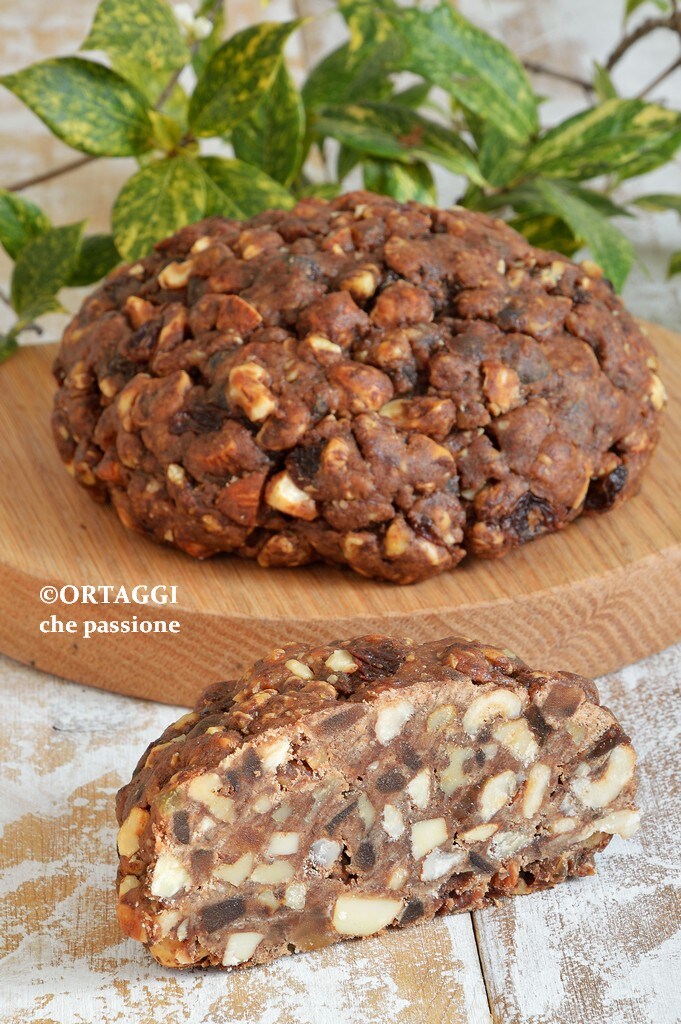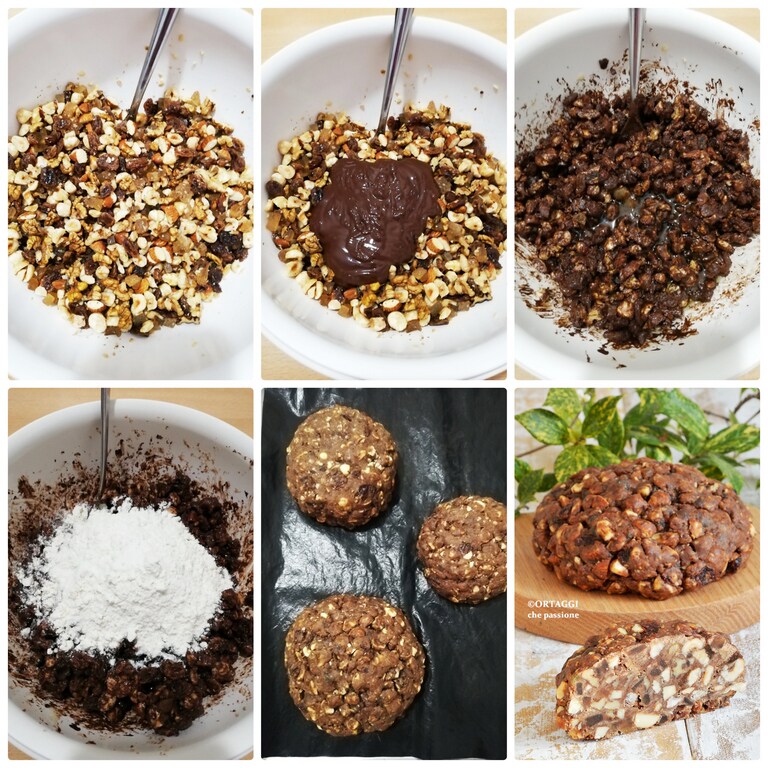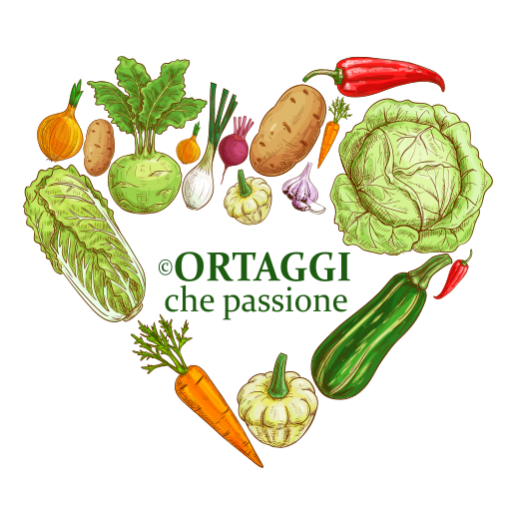Panpepato is the holiday and Christmas dessert, a traditional recipe of ancient origin with an intense, rich, spicy, and fragrant flavor. Each area and family has its own version of this ancient popular confectionery preparation.
My version is based on the Ciociaro Panpapato from Agnani (Frosinone – Lazio). Other panpepato versions include the Tuscan one from Siena (often called Black Panforte), the Emilian one from Ferrara, the IGP Pampapato from Terni (Umbria) specifically from the San Valentino area, or the Miacetto from Cattolica. Here is the preparation with bimby.
RECIPE without eggs, lactose, and yeast.
Other traditional dessert recipes

- Difficulty: Easy
- Cost: Expensive
- Preparation time: 1 Hour
- Portions: Servings for 3 small panpepati
- Cooking methods: Oven
- Cuisine: Italian Regional
- Region: Lazio
- Seasonality: Christmas
- Energy 408.53 (Kcal)
- Carbohydrates 59.99 (g) of which sugars 30.82 (g)
- Proteins 7.77 (g)
- Fat 17.80 (g) of which saturated 4.43 (g)of which unsaturated 12.54 (g)
- Fibers 8.50 (g)
- Sodium 8.47 (mg)
Indicative values for a portion of 100 g processed in an automated way starting from the nutritional information available on the CREA* and FoodData Central** databases. It is not food and / or nutritional advice.
* CREATES Food and Nutrition Research Center: https://www.crea.gov.it/alimenti-e-nutrizione https://www.alimentinutrizione.it ** U.S. Department of Agriculture, Agricultural Research Service. FoodData Central, 2019. https://fdc.nal.usda.gov
Panpepato
- 5.3 oz sultana raisins
- 5.3 oz hazelnuts (peeled)
- 5.3 oz almonds (shelled)
- 10.6 oz candied fruits (of citron and/or orange, or dried figs)
- 5.3 oz dark chocolate
- 8.5 oz honey (or agave syrup for vegans)
- 2 1/3 cups flour (gluten-free for celiacs, whole wheat for a more rustic result)
- 2 teaspoons black pepper (freshly ground)
- 4 cloves (freshly ground)
- 1/2 teaspoon nutmeg (or ground mace)
- 1 teaspoon ground cinnamon (not included in the original recipe)
- 1/2 teaspoon ground coriander (optional)
Quantities can be adjusted according to personal tastes or available ingredients. The final result will always be rich in flavor.
You can add:
– pine nuts, pistachios
– unsweetened cocoa
– coffee, liqueur, vinsanto
– grape must or cooked wine must (in Umbrian pampepato)
– runzón, a whole wheat flour with bran (typical of Cattolica).
🍀🍀🍀🍀
How many calories does panpepato have?
Below are the calories for a 100-gram slice.
Tools
- Bowl for sweets
- Parchment paper reusable
Panpepato
Prepare the ingredients
RAISINS: soak in warm water for 15 minutes or more, then drain and gently squeeze before adding to the other ingredients.
DRIED FRUITS: leave whole, break into 2 or 3 pieces with the blade of a knife, or coarsely chop with an electric mixer.
CANDIED FRUITS (or dried figs): if necessary, cut into regular pieces.
CLOVES and BLACK PEPPER: grind to a powder with a grinder or with a mortar.
NUTMEG: grate at the last moment.
CINNAMON: use the ground one.
DARK CHOCOLATE: melt in a bain-marie or microwave, or alternatively, add directly as flakes with other ingredients.
HONEY (or maple syrup for vegans): if necessary, gently heat in a saucepan or microwave to make it fluid.
Procedure
In a large bowl, pour all the prepared ingredients as mentioned above, first the solid ones and then the melted ones (chocolate and honey), then mix everything with a spoon or better with your hands.
Now gradually add the flour and knead with your hands until the dough becomes homogeneous.
Let the mixture rest in the fridge overnight, either whole or already divided into 2 or 3 spherical dome-shaped panpepati (form them tightly, squeezing them well with your hands and flatten them on a baking sheet covered with parchment paper, if necessary, tap them on the work surface to make them compact). Alternatively, you can shape it like a strudel.
The resting time is not necessary, but it is recommended to allow the flavors to blend together.
Bake in a static oven at 340 °F for 40 minutes (or at 285 °F for 1 hour). If desired, 10 minutes before the end of cooking, you can glaze the panpepati with fluid honey or cooked must, then continue cooking.
Once ready, you can cover the top with melted chocolate or sprinkle with powdered sugar, cocoa powder, or cinnamon enriched with your favorite spices.
The day after and in the following days, panpepato is more flavorful.

Storage
Panpepato can be stored for a month (even for three months) covered with aluminum foil or cling film. Over time, the flavors meld together better and it becomes more delicious.
VARIANTS
The Panpapato from Ferrara (Emilia-Romagna) is dome-shaped and covered with dark chocolate, this is the original recipe:
Pampapato from Ferrara IGP
INGREDIENTS: 200 g of flour, 100 g of almonds, 100 g of sugar (better honey), 100 g of cocoa powder, 100 g of chopped candied fruit, 2 g of cinnamon, 2 g of ground cloves, 80 g of dark chocolate for the coating.
PROCEDURE: with your hands, knead in warm water (or milk) the indicated ingredients, work for a long time, until you obtain a fairly firm dough. Shape the panpepato and give it the characteristic dome shape. Bake it in an oven, preferably wood-fired. Once cooked and cold, glaze with melted dark chocolate.
The Black Panforte from Siena (Tuscany) is a traditional dessert from the city of the Palio, it is cooked on a sheet of wafer and inside a cake mold, before serving it is sprinkled with powdered sugar or powdered spices.
Curiosities
Where was panpepato born?
Panpepato has a history shrouded in legends and ancient traditions, with uncertain origins that generate various variations in different regions of Italy. It is believed that this dessert has medieval roots, as indicated by its name suggesting the predominant use of pepper in the original recipe. Ingredients like dried fruits, honey, and chocolate were added to evoke wealth and prosperity, auspices for the new year.
There are those who hypothesize that panpepato dates back to the ancient Romans when the custom of preparing sweets with milk, eggs, dried fruits, and wine, sweetened with honey water, was widespread. During the 12th century, the influence of spiced breads based on honey from the East contributed to the tradition. The first written evidence of panpepato dates back to 1205, when the nuns of the Monastery of Montecelso near Siena received a gift of “panes piperatos et melatos,” starting to produce them with honey, candied fruits, almonds, spices, and ginger. The custom of enriching sweets with these ingredients became widespread in Tuscany, as demonstrated by the panforte from Siena exported and consumed even in Venice around 1370.
Many variations of panpepato have monastic origins, such as the one from Ferrara linked to the convent of Corpus Domini or the Roman pangiallo, which also includes the use of raisins.How many types of Panpepato?
The Terni pampepato is a dessert dating back to the 16th century with possible oriental origins, enriched with local flavors such as walnuts, citrus, and cooked must. Its peasant tradition manifests in the strict preparation on December 8 (beginning of the festivities), which sometimes extends to February 14 (Saint Valentine), the patron saint of the city and lovers. It is customary to leave at least one piece wrapped until Easter or even Assumption (August 15), demonstrating its prolonged durability without preservatives. The original recipe does not provide precise doses, indicating the addition of ingredients “as needed” to achieve the right flavor. This dessert received the IGP brand in 2021.
The Siena panpepato has its roots in the medieval period. During the 1800s, a new type of pampepato was created, with a powdered sugar coating, and in homage to Queen Margherita, it was called Panforte Margherita.
The Ferrara pampapato has origins in the convents of Ferrara in the 15th century, during the influence of the Papal State. The dessert, also known as “Pan del Papa,” became popular at the court of the Este family with strong oriental influences. Its typical preparation includes dark chocolate, hazelnuts, almonds, cinnamon, and pepper. To be consumed fresh and soft, pampapato represents a Christmas delight with a deep chocolate aroma.
The panpepato from Anagni has origins in the 12th and 13th centuries, when the city was the seat of the papal curia, as indicated also by its alternative name, Panpapato (Bread of the Pope). This dessert is made with dried fruits (walnuts, almonds, hazelnuts, pine nuts), dark chocolate, cooked wine must (or honey), and sometimes candied orange peel and raisins. It differs from the Ferrara panpepato for a less pronounced use of chocolate, the absence in the glazing, the lack of cinnamon, and the presence of cooked wine must.
The miacetto is a typical Christmas dessert from Cattolica, in the province of Rimini. Its preparation includes dried fruits, sugar, bran (or flour), and honey, without the use of yeast. The name derives from the Latin “milaceus” (= of millet), connecting to the term “migliaccio” used in different regions of Italy to indicate unleavened cakes, which can be savory or sweet. Miacetti are prepared in homes during the Christmas holidays and are also on sale at pastry shops and bakeries. In Cattolica, the tradition of preparing and gifting miacetti to relatives and friends has a deep significance in strengthening ties with people, both in the present and past.

